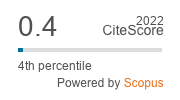Antixenosis of Thodan (AAB), a resistant Musa cultivar to Odoiporus longicollis (Olivier) and characterization of larvicide molecules
DOI:
https://doi.org/10.33307/entomon.v48i1.842Abstract
Banana pseudostem borer (BPB) Odoiporus longicollis (Olivier) (Coleoptera, Curculionidae) is a serious pest of Musa cultivars. Experimental maintenance of larvae in the live pseudostem of cultivar Thodan, a resistant AAB Musa cultivar has resulted antixenosis followed by death of larvae within a week. Antixenosis was characterized by significant decrease of total hemocytes and sharp changes on the proportionate distribution of different types of hemocytes in larvae. As the number of plasmatocytes, prohemocytes, splenocytes and adipohemocytes decreased the number of granulocytes and oenocytes increased. Antixenosis also caused accumulation of 20-hydroxyecdysone (20E) and significant inhibition on the activities of trypsin like serine protease (TlSP) and phenoloxidase (PO). Phytochemical analysis of Thodan resulted characterization of three larvicides such as Betulinic acid (BA), Stigmasterol-3-O-glucoside (SOG) and Sulfoquinovosyl diacyl glycerol (SQDG), and the content in the pseudostem ranged 0.0027 to 0.007 per cent. All the three larvicides were highly toxic to the larvae with LD50 of 0.38 ppm for SOG, 0.41 ppm for SQDG and 0.83 ppm for BA. Simultaneous action of three larvicides in the live pseudostem resulted resistance in Thodan against infestation by BPB. Susceptible Nendran showed negligibly low content of SOG (0.0011%) and SQDG (0.0013%) but no detectable quantity of BA. Intoxication by all the three larvicides caused significant changes on the proportionate distribution of hemocytes, accumulation of 20-hydroxy ecdysone (20E) and inhibition of TlSP and PO, the enzymes involved in larval metamorphosis and cuticle sclerotisation. This study demonstrated that resistance of Thodan against O. longicollis is due to adverse effect of these larvicides on endocrine system, cuticle development and cytotoxicity of hemocytes. As these larvicide molecules are stable compounds, there is scope for them to be used as substitutes in place of deleterious insecticides for the management BPB.


